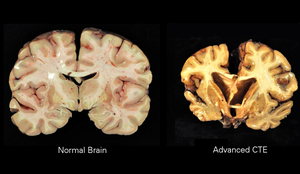
Chronic traumatic encephalopathy

Chronic traumatic encephalopathy (CTE) is a neurodegenerative disease caused by repeated head injuries. Symptoms may include behavioral problems, mood problems, and problems with thinking. Symptoms typically do not begin until years after the injuries. CTE often gets worse over time and can result in dementia. It is unclear if the risk of suicide is altered. Chronic traumatic encephalopathy (CTE) is a neurodegenerative disease caused by repeated head injuries. Symptoms may include behavioral problems, mood problems, and problems with thinking. Symptoms typically do not begin until years after the injuries. CTE often gets worse over time and can result in dementia. It is unclear if the risk of suicide is altered. Most documented cases have occurred in athletes involved in contact sports such as boxing, American football, professional wrestling, ice hockey, rugby and soccer. Other risk factors include being in the military, prior domestic violence, and repeated banging of the head. The exact amount of trauma required for the condition to occur is unknown. Definitive diagnosis can only occur at autopsy. Chronic traumatic encephalopathy is a form of tauopathy. There is no specific treatment. Rates of disease have been found to be about 30% among those with a history of multiple head injuries. Population rates, however, are unclear. Research in brain damage as a result of repeated head injuries began in the 1920s, at which time the condition was known as dementia pugilistica or 'punch drunk syndrome'. Changing the rules in some sports has been discussed as a means of prevention. Symptoms of CTE, which occur in four stages, generally appear eight to ten years after an individual experiences repetitive mild traumatic brain injuries. First-stage symptoms include attention deficit hyperactivity disorder as well as confusion, disorientation, dizziness, and headaches. Second-stage symptoms include memory loss, social instability, impulsive behavior, and poor judgment. Third and fourth stages include progressive dementia, movement disorders, hypomimia, speech impediments, sensory processing disorder, tremors, vertigo, deafness, depression and suicidality. Additional symptoms include dysarthria, dysphagia, cognitive disorders such as amnesia, and ocular abnormalities, such as ptosis. The condition manifests as dementia, or declining mental ability, problems with memory, dizzy spells or lack of balance to the point of not being able to walk under one's own power for a short time and/or Parkinsonism, or tremors and lack of coordination. It can also cause speech problems and an unsteady gait. Patients with CTE may be prone to inappropriate or explosive behavior and may display pathological jealousy or paranoia. Most documented cases have occurred in athletes with mild repetitive brain trauma (RBT) over an extended period of time. Specifically contact sports such as boxing, American football, wrestling, ice hockey, rugby, and soccer. Other potential risk factors include military personnel (repeated exposure to concussions charges or large caliber ordnance), domestic violence, and repeated banging of the head. The exact amount of trauma required for the condition to occur is unknown. The neuropathological appearance of CTE is distinguished from other tauopathies, such as Alzheimer's disease. The four clinical stages of observable CTE disability have been correlated with tau pathology in brain tissue, ranging in severity from focal perivascular epicenters of neurofibrillary tangles in the frontal neocortex to severe tauopathy affecting widespread brain regions.
